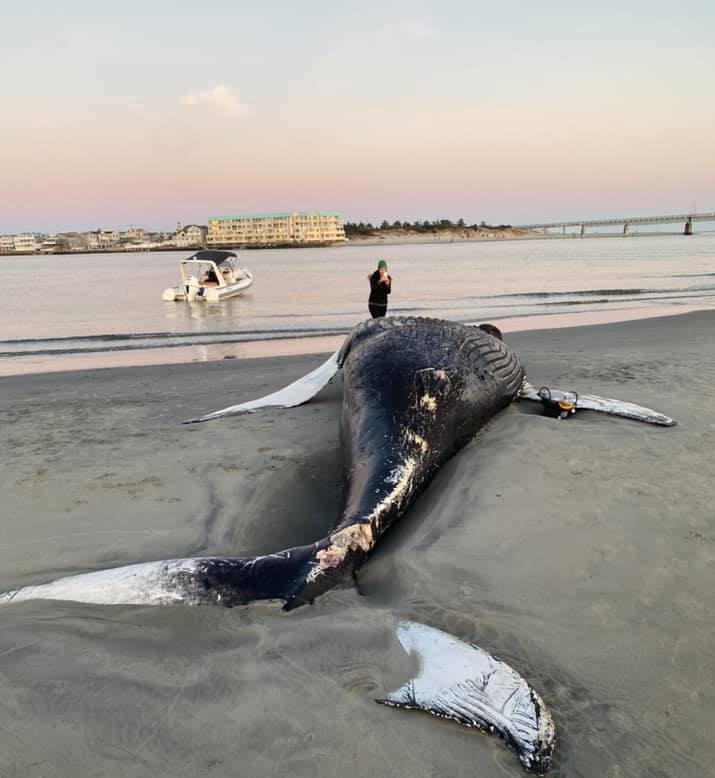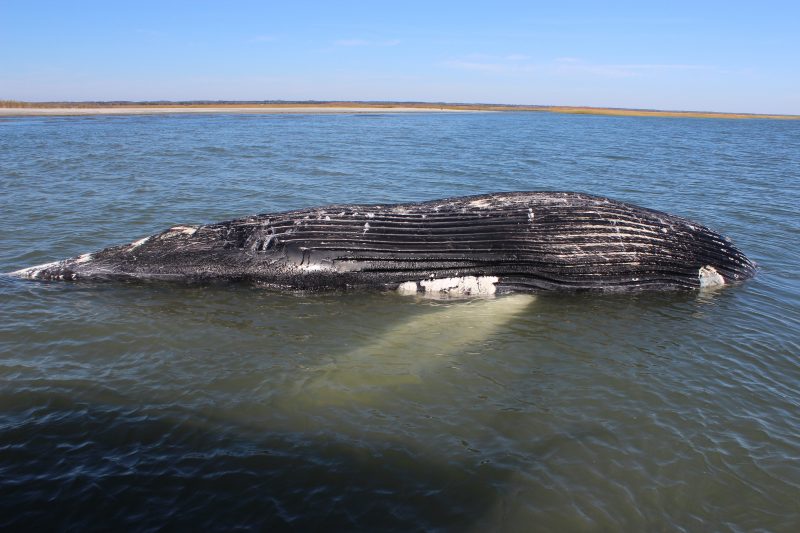The humpback whale carcass is decaying on a sandbar in Townsends Inlet. (Photo courtesy of Carefree Boat Club of South Jersey)
 By DONALD WITTKOWSKI
By DONALD WITTKOWSKI The dead whale was discovered Nov. 4 floating in the waters between Sea Isle City and Avalon. (Photo courtesy of Marine Mammal Stranding Center)
Bite marks were seen on the carcass, suggesting that sharks were feeding on it before it became stuck on the sandbar.
There is a possibility that unusually high tides caused by the new moon Sunday night could lift the whale off the sandbar and sweep it back into Townsends Inlet and eventually take it out into the ocean, Peacock said.
Another possibility is that the carcass may wash up on the beach on the Sea Isle or Avalon side of Townsends Inlet if the tide moves it off the sandbar. In that scenario, the town where the whale ends up would be responsible for disposing of the remains, Peacock said.
Normally, whale carcasses are buried on the beach. Sea Isle buried a 33-foot humpback whale that washed ashore near the 20th Street beach in September 2016.
Typically, about a dozen dead whales wash ashore or are discovered dead in the waters along the Jersey Shore each year, Peacock said.
In September, a humpback whale was found dead in the water near Brigantine after becoming entangled in fishing gear.
Humpback whales are common at the Jersey Shore throughout the year. Their presence is a sign of a strong ecosystem, Peacock explained.
The dead whale was discovered Nov. 4 floating in the waters between Sea Isle City and Avalon. (Photo courtesy of Marine Mammal Stranding Center)
Bite marks were seen on the carcass, suggesting that sharks were feeding on it before it became stuck on the sandbar.
There is a possibility that unusually high tides caused by the new moon Sunday night could lift the whale off the sandbar and sweep it back into Townsends Inlet and eventually take it out into the ocean, Peacock said.
Another possibility is that the carcass may wash up on the beach on the Sea Isle or Avalon side of Townsends Inlet if the tide moves it off the sandbar. In that scenario, the town where the whale ends up would be responsible for disposing of the remains, Peacock said.
Normally, whale carcasses are buried on the beach. Sea Isle buried a 33-foot humpback whale that washed ashore near the 20th Street beach in September 2016.
Typically, about a dozen dead whales wash ashore or are discovered dead in the waters along the Jersey Shore each year, Peacock said.
In September, a humpback whale was found dead in the water near Brigantine after becoming entangled in fishing gear.
Humpback whales are common at the Jersey Shore throughout the year. Their presence is a sign of a strong ecosystem, Peacock explained.